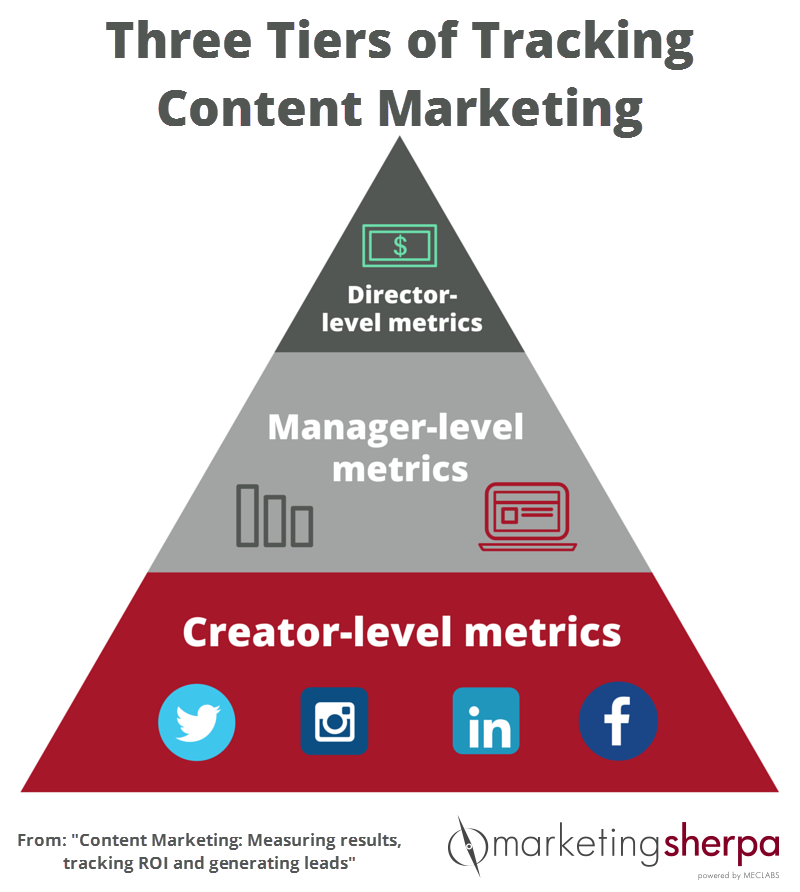Content Marketing: Measuring results, tracking ROI and generating leads
One of my recent MarketingSherpa Blog posts, “Content Marketing 101: Tips on content strategy” covered some basics of content marketing. For today’s post, I want to dig into the MarketingSherpa Newsletter archive to highlight what can be a challenging aspect of content marketing — quantifying and proving its worth.
The first article to highlight is a how-to, titled “Measuring Content Marketing: How to measure results, find gaps and grab opportunities,” that covers a range of tactics offered by Joe Pulizzi, Founder, Content Marketing Institute, and Michal Brenner, Senior Director, Global Integrated Marketing, SAP, on quantifying your content marketing efforts.
Joe says to set three categories of goals for content — driving sales, saving money and making customers happier.
To reach these goals, he suggested tracking those goals in three tiers:
Creator-level metrics
For a company blog, these KPIs include traffic metrics, such as page views and unique visitors; source metrics, such as inbound search results and referring sites; and sharing metrics, such as tweets.
Manager-level metrics
These KPIs include lead volume generated, lead quality, cost-per-lead and conversion rate.
Director-level metrics
At the highest level, content KPIs include revCreatienue, costs, ROI and customer lifetime value.
Analytics also plays a role in content marketing.
Michael suggests that Google Analytics can be a content marketer’s best friend because the free tool allows tracking of the most downloaded, shared and viewed content on the website, sources of inbound traffic and organic search keywords used to reach your site.
Joe added, “We’re so infatuated with the creative that we don’t take two seconds to look at how this is making an impact on our customers. [Tracking software] is not glamorous. I can’t hold or touch or feel it, but you can take that feedback from the technology and then improve the content you have.”
Generating leads with content
A case study, “Content Marketing: How an energy data company’s content strategy increased leads by 733%,” details how Urjanet, a company that provides energy data to companies and organizations, utilized content such as:
- Infographics
- Expert Q-and-As
- Videos
- White papers
- Case studies
- Events
- Webinars
This content marketing was used to boost demand generation over a six-month campaign.
This effort involved taking a big picture look at yearly revenue forecasts to determine how many leads — broken down into sales-accepted, sales-qualified and closures — needed to be generated during the campaign. That number ended up 500 total leads per quarter.
The process included taking the time to understand its customers’ needs and building content that would be relevant — what the team termed “WIIFM,” or “what’s in it for me?” — by taking the buyer’s perspective.
Another key element of the campaign was developing a content calendar that covered types of content to be created, a timetable for publication and distribution and topics the content would address.
The end result of this effort was a 733% increase in leads generated by Urjanet’s team.
A final case study for us to review — “Content Marketing: 172% ROI for online retailer’s high-powered blog” — covers a blog campaign from ZAGG, a mobile device accessory provider, which had a direct impact on the bottom line.
The first step in this campaign was a conscious effort to focus the blog on sales, rather than awareness or search traffic.
Drew Conrad, Internet Marketing Specialist, ZAGG, said, “We write about our products as much as we can. We don’t want to overwhelm people. … We write about things as they naturally come up, whether it’s a new product, promotion or a giveaway.”
Referring to the ambitious publishing schedule of up to 35 posts each week, he added, “Unless you are willing to go into it full speed ahead, it’s going to be hard to make a blog worth your time.”
The overall effort included several elements:
- Driving social sharing
- Encouraging shopping
- Selectively promoting posts
- Not overemphasizing SEO
This entire campaign was built on the basis of a three-month trial when the blog initially launched in 2011. During that time, the team saw a correlation between content and revenue in that when more content was published (hence the eventually high post volume strategy), the blog received more traffic and, as a result, ZAGG earned more sales.
How much of each? The blog generates more than 10% of ZAGG’s website traffic and it earns 172% ROI from direct sales.
You can follow David Kirkpatrick, Reporter, MECLABS Institute on Twitter at @davidkonline.
You might also like
B2B Content Marketing: Threefold increase in closed deals from e-book effort [MarketingSherpa case study]
Ecommerce: How Wine Enthusiast increased organic traffic 154% with content marketing [MarketingSherpa case study]
Ecommerce: Manufacturer’s revamped website strategy leads to 26.3% lift in sales [MarketingSherpa case study]
Content Marketing: An 8-point analysis for your blog [More from the blogs]
Categories: Marketing blog, content marketing, lead generation, ROI, website analytics











Your right about the importance and role of analytics in tracking performance. A dollar value can be assigned to different pieces of content to differentiate which content generated the most revenue and therefore develop more of hat content.
Great piece on analytics. I’ve included this in my top 5 feature on my blog – http://bit.ly/1JUqUki.
I included the triangle image above with a link to this article. Are you okay with me using it? Thanks.